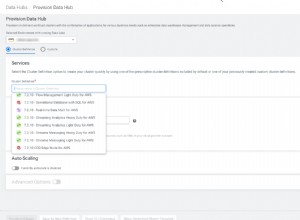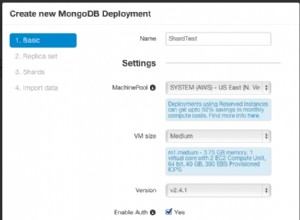Ostatnio zrobiłem coś takiego. Użyłem angular-file-upload . Będziesz także potrzebować node-multiparty dla punktu końcowego do przeanalizowania danych formularza. Następnie możesz użyć s3 za przesłanie pliku do s3.
Oto część mojego [edytowanego] kodu.
Szablon kątowy
<button>
Upload <input type="file" ng-file-select="onFileSelect($files)">
</button>
Kontroler kątowy
$scope.onFileSelect = function(image) {
$scope.uploadInProgress = true;
$scope.uploadProgress = 0;
if (angular.isArray(image)) {
image = image[0];
}
$scope.upload = $upload.upload({
url: '/api/v1/upload/image',
method: 'POST',
data: {
type: 'profile'
},
file: image
}).progress(function(event) {
$scope.uploadProgress = Math.floor(event.loaded / event.total);
$scope.$apply();
}).success(function(data, status, headers, config) {
AlertService.success('Photo uploaded!');
}).error(function(err) {
$scope.uploadInProgress = false;
AlertService.error('Error uploading file: ' + err.message || err);
});
};
Trasa
var uuid = require('uuid'); // https://github.com/defunctzombie/node-uuid
var multiparty = require('multiparty'); // https://github.com/andrewrk/node-multiparty
var s3 = require('s3'); // https://github.com/andrewrk/node-s3-client
var s3Client = s3.createClient({
key: '<your_key>',
secret: '<your_secret>',
bucket: '<your_bucket>'
});
module.exports = function(app) {
app.post('/api/v1/upload/image', function(req, res) {
var form = new multiparty.Form();
form.parse(req, function(err, fields, files) {
var file = files.file[0];
var contentType = file.headers['content-type'];
var extension = file.path.substring(file.path.lastIndexOf('.'));
var destPath = '/' + user.id + '/profile' + '/' + uuid.v4() + extension;
var headers = {
'x-amz-acl': 'public-read',
'Content-Length': file.size,
'Content-Type': contentType
};
var uploader = s3Client.upload(file.path, destPath, headers);
uploader.on('error', function(err) {
//TODO handle this
});
uploader.on('end', function(url) {
//TODO do something with the url
console.log('file opened:', url);
});
});
});
}
Zmieniłem to z mojego kodu, więc może nie działać po wyjęciu z pudełka, ale mam nadzieję, że jest to pomocne!




